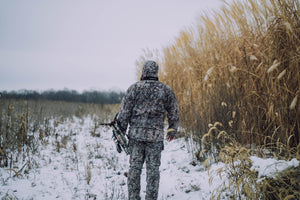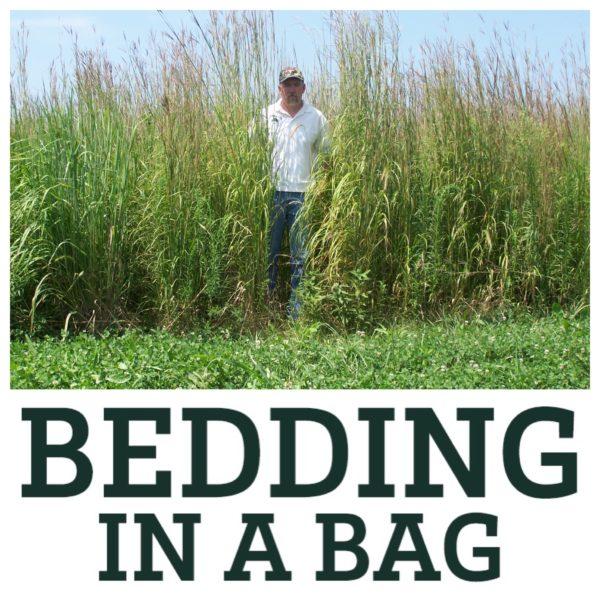Real World Bedding in a Bag
Tax included
Product = 7 LB. Bag = One Acre
Real World Wildlife Product's co-founder, Don Higgins, has worked for many years as a conservation contractor where he has planted thousands of acres of warm-season native grasses. Through this experience, he noticed that some species of these grasses stood up to the elements such as wind and snow better than others. Furthermore, Don noticed that different varieties of the same species would also stand up better to the weather than others. This prompted Don and his business partner, Kevin Boyer, to begin planting side-by-side test plots of these grasses using every variety that they could get their hands on. The result is Real World's “Bedding in a Bag”, a superior blend of tall, warm-season grasses that makes excellent bedding cover for deer as well as nesting cover for pheasants, quail, rabbits and other wildlife.
Over the past several years, Real World customers have planted thousands of acres of this special blend containing Indian Grass, Big Bluestem and Switchgrass. We even had one customer plant 450 acres of it on his Iowa farm.
The key to this blend's success is not the species of grasses that are included, but instead, the specific variety of each grass species. In our development of this blend, we planted every variety of these species that we could find and observed them over several years for standability under adverse weather conditions. The result is a blend of native grasses that typically grow 6’-8’ tall and stands up very well to the elements. If you want to create bedding cover in a hurry on your property, Real World's “Bedding-In-A-Bag” is the ticket!
Planting and Maintenance Instructions
Establishing the warm season native grasses contained in the Real World’s “Bedding-in-a-Bag” mix can require some extra effort compared to other crops. This blend contains a total of 7# PLS (pure live seed) per acre. This is plenty of seed when a properly adjusted native grass planting drill is used. For other planting methods such as broadcast seeding you may need to plant at a higher rate per acre.Please keep this in mind when ordering.
Note – the switchgrass seed is in a separate bag than the mix of big bluestem and Indian grass, due to the differences in the seed itself. When using a native grass drill there will be multiple seed boxes. The mix of big bluestem and Indian grass should be used in the native grass box which should be set at a seeding rate of 5# per acre. The switchgrass seed should be placed in the small seeds box and it should be set at 2# per acre.
Proper Planting Time – RWWS Whitetail Bedding Mix should be planted in mid to late spring when soil temperatures approach 60 degrees. In most parts of the country, April and early May is the perfect time for most of the United States.
Planting Site – RWWS Whitetail Bedding Mix works best in open field areas with lots of sunlight and well to moderately well drained soils. These grasses will not establish well in areas with lots of shade or when in competition with other vegetation. They are also not well suited for areas that flood and stand in water for more than a few days or in “gumbo” type soils. pH is not critical for these grasses and they are suited for the entire United States. Like any plant, these grasses will grow better in more fertile soils. Most sites will not require additional fertilizer.
Site preparation and Planting – A good stand of RWWS Whitetail Bedding Mix can be achieved without any tillage of the soil provided the ground is free of other vegetation and a no-till drill is used for planting. Planting depth should be 1/8 inch. DO NOT PLANT TOO DEEP! Fields that have previously been in other crops are perfect for no-till planting of this mix.
Herbicide – It is very important to spray the planting site with a combination of Round-Up (glyphosate) and Plateau herbicides. Do NOT use more than 4 oz of Plateau per acre! Round-Up will kill any weeds growing on the site and Plateau is a herbicide specially designed for native grass plantings. It works as a residual (preventative) and will curtail later weed competition. This herbicide application is extremely important for getting your grass stand established quickly.
Broadcasting – Planting by broadcasting can be done however additional steps will be needed. This seed is very fluffy and difficult to broadcast but it can be done. To help the seed flow through a broadcast seeder, mix the seed with pelleted lime. When broadcasting you may need to use more seed per acre. You will also need to work the ground with a disc or other tillage tool, lightly drag the seedbed after broadcasting or preferably use a culti-packer to firmly press the seed into the soil for good seed-soil contact.
Do not attempt to establish these grasses unless the planting site is completely free of live vegetation!
Maintenance – It is not necessary to fertilize these grasses. If weeds become too bad during the year of planting you can spray the field with 2-4D herbicide which will kill all broadleaf weeds and plants but will not harm any grasses. Do not use 2-4D until these grasses have at least 4 leaves per plant. You can also mow the plot to help with weeds but do not mow lower than 12”. These grasses respond very well to fire. If possible, it is advised to burn off these grasses about every third year in the early spring before green up. Fire not only stimulates these grasses but also sets back weed competition and kills woody sprouts and seedlings. With regular burnings these grass stands can last for decades. Keep this in mind when planning your planting. In many situations it is a good idea to plant a firebreak around the edge of fields planted to these grasses. Real Worlds Clover & Chicory mix makes a good firebreak and also offers the deer a travel corridor and place to feed just outside of their bedding sanctuary.
Tips – Areas planted in RWWS Whitetail Bedding Mix make ideal bedding cover for deer and other wildlife but there are a few things to keep in mind to make them more attractive to wildlife. Very small fields (under 2 or 3 acres) are not nearly as attractive to game as larger fields (5 acres+). Fields of these grasses will not be utilized nearly as much if there is undue hunting pressure in or very near them. We suggest that you never enter your grass fields but instead use them as sanctuaries for the deer on your property and hunt around the field edges.
Note- RWWS Whitetail Bedding Mix may be used on some CRP (conservation reserve program) projects. You will likely need to add a small amount of other grasses and/or forbs to get a mixture that is acceptable to meet CRP specifications. In such cases you might not need to order as much seed as you have acres to plant. For example a 10 acre planting may use 8 acres of RWWS Whitetail Bedding mix and a few pounds of other seeds to be acceptable to USDA requirements. Be sure to check with your local NRCS/USDA office before using this mix on a CRP project or your funding could be in jeopardy.
Note – When planting warm-season native grasses for bedding cover, always remember that bigger is better when it comes to plot size. Deer are much more likely to bed in bigger plots of these grasses than smaller ones. On our own properties, we never plant plots of these grasses smaller than 5 acres.
Coverage: 1 acre per bag.




